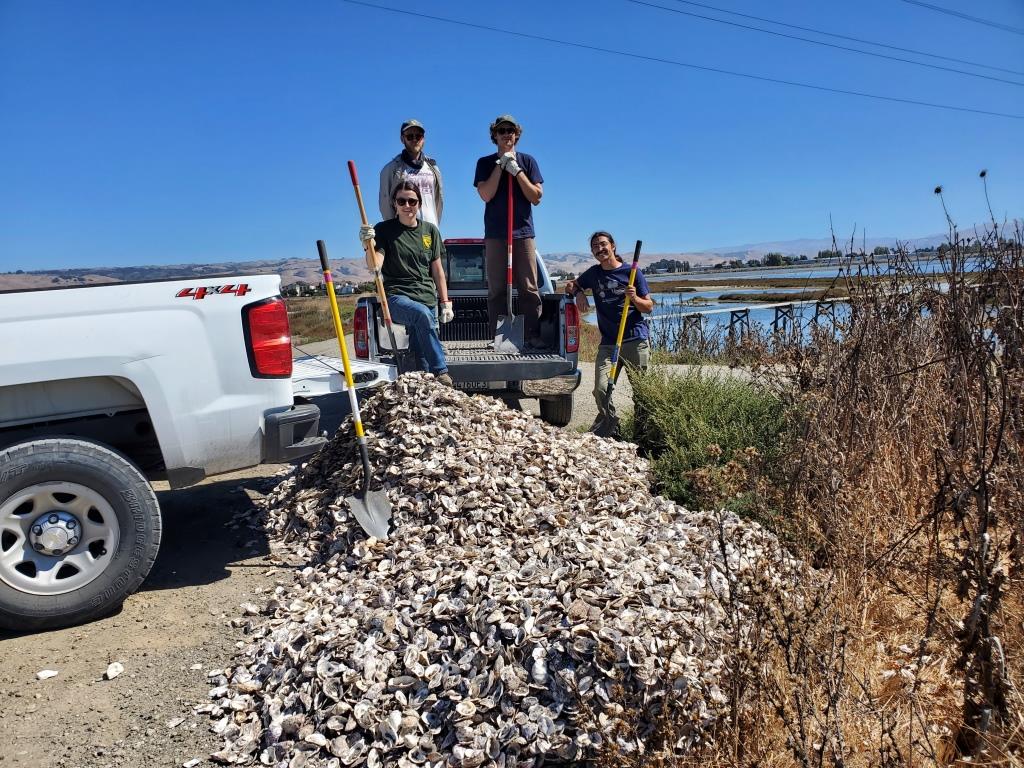Oysters on the Half-Ton (Pickup)!
Hi all – and Happy World Wetlands Day!
Crazy that it’s almost spring already, right? And just as time marches on, things here in Salty Dave’s Wetland Weblog World continue to roll along as well, in spite of sad news like the disappointing Golden State Warriors season.
As part of maintaining an even keel, it’s important to take the good with the bad, and part of doing that is counting the little victories we have as we go about our work and our lives.
One of those wins happened on our lands, and it involved restaurant waste products, a few pick-up trucks, and rapid and flexible action. Oh – and collaboration. As I’ve written previously (for example here and here), almost nothing we do succeeds without collaboration!
There is a super-cool and quite interesting group called The Wild Oyster Project (www.wildoysters.org). The Wild Oyster Project reaches out to oyster-serving restaurants in the Bay Area to promote the importance of restoring native oyster reefs in the Bay and some other coastal bays too. They convince them to not throw out the shells left over from dinner plates because it turns out that the larvae from native oysters in the Bay will settle on and then grow on shells from oysters that weren’t necessarily from here. A shortage of this kind of hard substrate for native oysters to settle on is one limiting factor in developing healthy populations of local oysters.
So the Wild Oyster Project works with these restaurants to hold onto the empty shells for a week or so until the Project’s volunteers can drive around and collect them. The volunteers then recruit both domestic and wild birds to help with a slow, passive process of shell “drying and curing.” They spread out the shells to dry in the sun, and bring in chickens to pick all the little barnacles and algae and stuff off of them. Also, gulls and other wild birds help out with that. This part is really important because we don’t want to contribute to the spread of wildlife or algae from other parts of the world into San Francisco Bay.*
After a year or two, the shells are clean and ready to reuse in constructed oyster reefs. For example, mesh bags full of shells can be piled up and anchored in appropriately deep Bay water (not too deep, but also not so shallow that low tides would repeatedly expose the mounds). These shell mounds can truly help restore habitat by expanding the areas on which oyster larvae can land on and grow.
That’s mostly what the Wild Oyster Project does and how it does it. Pretty cool so far, right? Well, it gets better. Because oyster shells are also really helpful for endangered western snowy plovers – they can be spread around dry pond bottoms where plovers nest to provide texture and camouflage eggs and chicks from predators. So we are always looking for oyster shells! In fact, we help the San Francisco Bay Bird Observatory (SFBBO) with one or two plover habitat improvement projects each year, which often involve recruiting volunteers to help us scatter these shells around on the salt flats (for those of you on Instagram, see some fun SFBBO volunteer story highlights).
This past October, the Wild Oyster Project’s Director, Linda Hunter, contacted me because she urgently needed to find another home for a huge pile of their dried and cured shells.
So, we scrambled, and assembled a team to relocate the 3,200 pounds (!) of fully dried and cured oyster shells to the California Department of Fish and Wildlife’s (CDFW) Eden Landing Ecological Reserve in Hayward. A crew of staffers from CDFW, SFBBO, and the Wild Oyster Project used tarps and pick-up trucks to load and haul the shells from Alameda to Eden Landing, where they are waiting for our next volunteer plover habitat enhancement effort on March 2!
For that event, we will work with SFBBO's Plover Program to set up a volunteer opportunity to scatter the shells around an Even Landing pond. Hey…here’s an idea…you should consider joining us at the volunteer day!
This is a wonderful example of networking and collaboration and being ready to help each other out to mutual benefit. I and the rest of the South Bay Salt Pond Restoration Project team are deeply grateful for all of the entities involved in this process – especially the Wild Oyster Project for sharing their shells with us. This all came together in less than a week!
In addition to recommending that you consider volunteering for one of the plover habitat enhancement days this spring, I’d also make a pitch to our readers and followers to think about whether you might have access to about 800 square feet that could be set aside for future use as an oyster shell drying and curing location. That’s all it takes – just 800 square feet! As it turns out, space for drying and curing is the limiting factor on the Wild Oyster Project's work, so if we could help them find some of that, we could keep all of these good vibes flowing. Please contact them here if you have any ideas for that – or…if you just want to help collect shells from local restaurants.
Thanks so much and have a great spring!
*We have enough problems with that already here in the Bay. No reason to make it worse…


